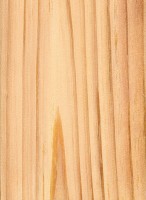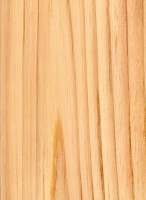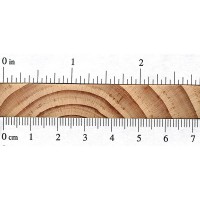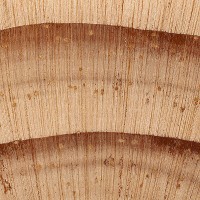 |
Common Name(s): Austrian Pine, European Black Pine Scientific Name: Pinus nigra Distribution: Mediterranean regions of Europe and Asia Minor Tree Size: 65-115 ft (20-35 m) tall, 2-3 ft (.6-1 m) trunk diameter Average Dried Weight: 30 lbs/ft3 (475 kg/m3) Specific Gravity (Basic, 12% MC): .39, .48 Janka Hardness: 660 lbf (2,920 N) Modulus of Rupture: 9,340 lbf/in2 (64.4 MPa) Elastic Modulus: 1,568,000 lbf/in2 (10.81 GPa) Crushing Strength: 5,570 lbf/in2 (38.4 MPa) Shrinkage: Radial: 4.1%, Tangential: 7.3%, Volumetric: 11.4%, T/R Ratio: 1.8 |
Color/Appearance: Heartwood is light reddish brown, wide sapwood is pale yellow to nearly white.
Grain/Texture: Grain is straight, with a medium, even texture.
Endgrain: Medium sized resin canals, numerous and evenly distributed, mostly solitary; earlywood to latewood transition fairly abrupt, color contrast medium; tracheid diameter medium-large.
Rot Resistance: Heartwood is rated as moderately durable to non-durable regarding decay resistance.
Workability: Austrian Pine is easy to work with both hand and machine tools. Glues and finishes well.
Odor: Austrian Pine has a mild, resinous odor when being worked.
Allergies/Toxicity: Working with pine has been reported to cause allergic skin reactions and/or asthma-like symptoms in some people. See the articles Wood Allergies and Toxicity and Wood Dust Safety for more information.
Pricing/Availability: Austrian Pine is commonly harvested for construction lumber and pulpwood. Expect prices to be moderate within its natural growing range.
Sustainability: This wood species is not listed in the CITES Appendices, and is reported by the IUCN as being a species of least concern.
Common Uses: Paper (pulpwood), boxes/crates, and construction lumber.
Comments: Austrian Pine has at least two recognized subspecies, as well as a number of varieties. Recently, the species has been afflicted by the fungal disease known as red band needle blight, causing a major decline in the species in the United Kingdom.
- Caribbean Pine (Pinus caribaea)
- Eastern White Pine (Pinus strobus)
- Jack Pine (Pinus banksiana)
- Jeffrey Pine (Pinus jeffreyi)
- Khasi Pine (Pinus kesiya)
- Limber Pine (Pinus flexilis)
- Loblolly Pine (Pinus taeda)
- Lodgepole Pine (Pinus contorta)
- Longleaf Pine (Pinus palustris)
- Maritime Pine (Pinus pinaster)
- Ocote Pine (Pinus oocarpa)
- Patula Pine (Pinus patula)
- Pinyon Pine (Pinus edulis)
- Pitch Pine (Pinus rigida)
- Pond Pine (Pinus serotina)
- Ponderosa Pine (Pinus ponderosa)
- Radiata Pine (Pinus radiata)
- Red Pine (Pinus resinosa)
- Sand Pine (Pinus clausa)
- Scots Pine (Pinus sylvestris)
- Shortleaf Pine (Pinus echinata)
- Slash Pine (Pinus elliottii)
- Spruce Pine (Pinus glabra)
- Sugar Pine (Pinus lambertiana)
- Sumatran Pine (Pinus merkusii)
- Table Mountain Pine (Pinus pungens)
- Western White Pine (Pinus monticola)
- Virginia Pine (Pinus virginiana)
 |
 |
 |
 |


I recently slabbed one out and it produced a beautiful slab. Hardest stuff I’ve ever cut.
In the pyrinees of spain it’s possible to see big dead trees of 30 or more years ago and they stand in nice conditions.
“Pinus nigra” are very slow growing trees, the grain is tight as “thuja plicata”(redcedar) and is one of the heavyest pines in spain (590kg/m3)
I’m milling about 100 of these trees about 24 to 12 inches diameter for fences poles and 2 inch boards to face them is this crazy. Its for schools and orchards. Free wood that needs use
Is it a good tree to make 8×8 or 12×12 beams out for making a picnic structure by a lake. We have a lot of these trees at our church grounds.